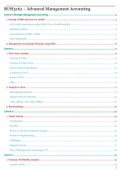Exam (elaborations)
Exam notes for BUSI3162 AMA
- Course
- Institution
- Book
The notes are structured in a way to answer exam questions. Includes: Strategic Management Accounting; Value Chain Analysis; Target Costing; Customer Profitability Analysis; Cost and Quality; Management Accounting Control Systems; Budgeting; Levers of Control; Integrated Reporting; Big Data.
[Show more]




